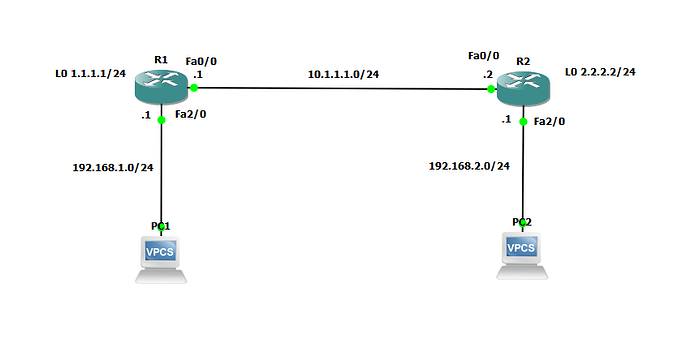Hello Laz,
Thank you for the response!
Im confused by your statements that mention that the subnet mask of the interfaces are also taken into account when using the network command to enable EIGRP (or OSPF) on certain interfaces.
I was under the impression that the network command only took into account an interfaces IP address, and not the subnet mask configured on them. Once an interface matches the network statement (via its IP), then the prefix thats actually advertised would 100% depend on the subnet mask configured on the interfaces.
Therefore I have not found it to be the case that I can only use the 0.0.0.0 wildcard statement to enable interfaces that are configured with a /32 mask, it should work as long as the interface has that IP address configured on it regardless of what mask its using.
I ran a quick lab on GNS3 with R1 and R2 being directly connected to eachother via Fa0/0 using a 10.1.1.0/24 network, then configured a loop0 in each using a /24 mask, and also configured Fa2/0 with a 192.168.1.1/24 on R1 and 192.168.2.1/24 on R2. I was able to enable EIGRP on the Loopback interfaces as well as on the Fa2/0 interfaces using a 0.0.0.0 statement even though they are not configured with a /32 mask and it worked fine. Each router was able to learn about eachothers networks via EIGRP:
R1:
interface Loopback0
ip address 1.1.1.1 255.255.255.0
!
interface FastEthernet0/0
ip address 10.1.1.1 255.255.255.0
duplex full
!
interface FastEthernet2/0
ip address 192.168.1.1 255.255.255.0
speed auto
duplex auto
!
interface FastEthernet2/1
no ip address
shutdown
speed auto
duplex auto
!
!
router eigrp 1
network 1.1.1.1 0.0.0.0
network 10.1.1.0 0.0.0.255
network 192.168.1.1 0.0.0.0
!
R1#sh ip route eigrp
Codes: L - local, C - connected, S - static, R - RIP, M - mobile, B - BGP
D - EIGRP, EX - EIGRP external, O - OSPF, IA - OSPF inter area
N1 - OSPF NSSA external type 1, N2 - OSPF NSSA external type 2
E1 - OSPF external type 1, E2 - OSPF external type 2
i - IS-IS, su - IS-IS summary, L1 - IS-IS level-1, L2 - IS-IS level-2
ia - IS-IS inter area, * - candidate default, U - per-user static route
o - ODR, P - periodic downloaded static route, H - NHRP, l - LISP
+ - replicated route, % - next hop override
Gateway of last resort is not set
2.0.0.0/24 is subnetted, 1 subnets
D 2.2.2.0 [90/156160] via 10.1.1.2, 00:22:10, FastEthernet0/0
D 192.168.2.0/24 [90/30720] via 10.1.1.2, 00:23:07, FastEthernet0/0
R2:
interface Loopback0
ip address 2.2.2.2 255.255.255.0
!
interface FastEthernet0/0
ip address 10.1.1.2 255.255.255.0
duplex full
!
interface FastEthernet2/0
ip address 192.168.2.1 255.255.255.0
speed auto
duplex auto
!
interface FastEthernet2/1
no ip address
shutdown
speed auto
duplex auto
!
!
router eigrp 1
network 2.2.2.2 0.0.0.0
network 10.1.1.0 0.0.0.255
network 192.168.2.1 0.0.0.0
!
R2#sh ip route eigrp
Codes: L - local, C - connected, S - static, R - RIP, M - mobile, B - BGP
D - EIGRP, EX - EIGRP external, O - OSPF, IA - OSPF inter area
N1 - OSPF NSSA external type 1, N2 - OSPF NSSA external type 2
E1 - OSPF external type 1, E2 - OSPF external type 2
i - IS-IS, su - IS-IS summary, L1 - IS-IS level-1, L2 - IS-IS level-2
ia - IS-IS inter area, * - candidate default, U - per-user static route
o - ODR, P - periodic downloaded static route, H - NHRP, l - LISP
+ - replicated route, % - next hop override
Gateway of last resort is not set
1.0.0.0/24 is subnetted, 1 subnets
D 1.1.1.0 [90/156160] via 10.1.1.1, 00:24:30, FastEthernet0/0
D 192.168.1.0/24 [90/30720] via 10.1.1.1, 00:24:30, FastEthernet0/0
Is there something I am not understanding right about the network command as it pertains to EIGRP/OSPF?
Thank You Laz
